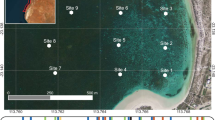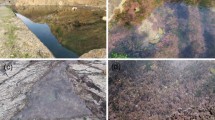Abstract
Cyanobacteria and diatom mats are ubiquitous in hypersaline environments but have never been observed in the Dead Sea, one of the most hypersaline lakes on Earth. Here we report the discovery of phototrophic microbial mats at underwater freshwater seeps in the Dead Sea. These mats are either dominated by diatoms or unicellular cyanobacteria and are spatially separated. Using in situ and ex situ O2 microsensor measurements we show that these organisms are photosynthetically active in their natural habitat. The diatoms, which are phylogenetically associated to the Navicula genus, grew in culture at salinities up to 40 % Dead Sea water (DSW) (14 % total dissolved salts, TDS). The unicellular cyanobacteria belong to the extremely halotolerant Euhalothece genus and grew at salinities up to 70 % DSW (24.5 % TDS). As suggested by a variable O2 penetration depth measured in situ, the organisms are exposed to drastic salinity fluctuations ranging from brackish to DSW salinity within minutes to hours. We could demonstrate that both phototrophs are able to withstand such extreme short-term fluctuations. Nevertheless, while the diatoms recover better from rapid fluctuations, the cyanobacteria cope better with long-term exposure to DSW. We conclude that the main reason for the development of these microbial mats is a local dilution of the hypersaline Dead Sea to levels allowing growth. Their spatial distribution in the seeping areas is a result of different recovery rates from short or long-term fluctuation in salinity.




Similar content being viewed by others
References
Allakhverdiev SI, Murata N (2008) Salt stress inhibits photosystems II and I in cyanobacteria. Photosynth Res 98:529–539
Allakhverdiev SI, Sakamoto A, Nishiyama Y et al (2000) Ionic and osmotic effects of NaCl-induced inactivation of photosystems I and II in Synechococcus sp. Plant Physiol 123:1047–1056
Allakhverdiev SI, Klimov VV, Hagemann M (2005) Cellular energization protects the photosynthetic machinery against salt-induced inactivation in Synechococcus. Biochim Biophys Acta (BBA)-Bioenergetics 1708:201–208
Altschul SF, Gish W, Miller W et al (1990) Basic local alignment search tool. J Mol Biol 215:403–410
Bhargava P, Srivastava A (2013) Salt toxicity and survival strategies of cyanobacteria. In: Srivastava AK, Rai AN, Neilan BA (eds) Stress biology of cyanobacteria. CRC Press, Boca Raton, pp 171–188
Bisson MA, Kirst GO (1995) Osmotic acclimation and turgor pressure regulation in algae. Naturwissenschaften 82:461–471
Bodaker I, Sharon I, Suzuki MT et al (2010) Comparative community genomics in the Dead Sea: an increasingly extreme environment. ISME J 4:399–407
Cacace MG, Landau EM, Ramsden JJ (1997) The Hofmeister series: salt and solvent effects on interfacial phenomena. Q Rev Biophys 30:241–277
Clavero E, Hernandez-Marine M, Grimalt JO, Garcia-Pichel F (2000) Salinity tolerance of diatoms from thalassic hypersaline environments. J Phycol 36:1021–1034
Elazari-Volcani B (1940) Algae in the bed of the Dead Sea. Nature 145:975
Elazari-Volcani B (1943a) Bacteria in the bottom sediments of the Dead Sea. Nature 152:274–275
Elazari-Volcani B (1943b) A dimastigamoeba in the bed of the Dead Sea. Nature 152:301–302
Elazari-Volcani B (1944) A ciliate from the Dead Sea. Nature 154:355
Farías ME, Rascovan N, Toneatti DM et al (2013) The discovery of stromatolites developing at 3570 m above sea level in a high-altitude volcanic lake Socompa. Argentinean Andes. PloS one 8:e53497
Garcia-Pichel F, Nübel U, Muyzer G (1998) The phylogeny of unicellular, extremely halotolerant cyanobacteria. Arch Microbiol 169:469–482
Giordano M, Beardall J, Raven JA (2005) CO2 concentrating mechanisms in algae: mechanisms, environmental modulation, and evolution. Annu Rev Plant Biol 56:99–131
Guillard RRL, Ryther JH (1962) Studies of marine planctonic siatoms: I. Cyclotella nana Hustest, and Detonula confervaccea (cleve) Gran. Can J Microbiol 8:229–239
Hallsworth JE, Yakimov MM, Golyshin PN et al (2007) Limits of life in MgCl2 containing environments: chaotropicity defines the window. Environ Microbiol 9:801–813
Häusler S, Noriega-Ortega BE, Polerecky L et al (2014) Microenvironments of reduced salinity harbour biofilms in Dead Sea underwater springs. Environ Microbiol Rep 6:152–158. doi:10.1111/1758-2229.12140
Hellebust JA (1985) Mechanisms of response to salinity in halotolerant microalgae. Plant Soil 89:69–81
Hopkinson BM, Dupont CL, Allen AE, Morel FMM (2011) Efficiency of the CO2-concentrating mechanism of diatoms. Proc Natl Acad Sci 108:3830–3837
Ionescu D, Lipski A, Altendorf K, Oren A (2007) Characterization of the endoevaporitic microbial communities in a hypersaline gypsum crust by fatty acid analysis. Hydrobiologia 576:15–26
Ionescu D, Siebert C, Polerecky L et al (2012) Microbial and chemical characterization of underwater fresh water springs in the Dead Sea. PloS one 7:21
Kaplan A, Reinhold L (1999) CO2 concentrating mechanisms in photosynthetic microorganisms. Annu Rev Plant Biol 50:539–570
Kirst GO (1990) Salinity tolerance of eukaryotic marine algae. Annu Rev Plant Biol 41:21–53
Kohls K, Abed RMM, Polerecky L et al (2010) Halotaxis of cyanobacteria in an intertidal hypersaline microbial mat. Environ Microbiol 12:567–575
Margheri MC, Ventura S, Kaštovský J, Komárek J (2008) The taxonomic validation of the cyanobacterial genus Halothece. Phycologia 47:477–486
Martin-Jézéquel V, Hildebrand M, Brzezinski MA (2000) Silicon metabolism in diatoms: implications for growth. J Phycol 36:821–840
McGee D, Laws RA, Cahoon LB (2008) Live benthic diatoms from the upper continental slope: extending the limits of marine primary production. Mar Ecol Prog Ser 356:103–112
Medlin L, Elwood HJ, Stickel S, Sogin ML (1988) The characterization of enzymatically amplified eukaryotic 16S-like rRNA-coding regions. Gene 71:491–499
Mostaert AS, Orlovich DA, King RJ (1996) Ion compartmentation in the red alga Caloglossa leprieurii in response to salinity changes: freeze substitution and X ray microanalysis. New Phytol 132:513–519
Murata N, Mohanty PS, Hayashi H, Papageorgiou GC (1992) Glycinebetaine stabilizes the association of extrinsic proteins with the photosynthetic oxygen-evolving complex. FEBS Lett 296:187–189
Nishri A, Ben-Yaakov S (1990) Solubility of oxygen in the Dead Sea brine. Hydrobiologia 197:99–104
Nübel U, Garcia-Pichel F, Muyzer G (1997) PCR primers to amplify 16S rRNA genes from cyanobacteria. Appl Environ Microbiol 63:3327–3332
Nübel U, Garcia-Pichel F, Kühl M, Muyzer G (1999) Spatial scale and the diversity of benthic cyanobacteria and diatoms in a salina. Hydrobiologia 401:199–206
Nübel U, Garcia-Pichel F, Clavero E, Muyzer G (2000) Matching molecular diversity and ecophysiology of benthic cyanobacteria and diatoms in communities along a salinity gradient. Environ Microbiol 2:217–226
Ohnishi N, Murata N (2006) Glycinebetaine counteracts the inhibitory effects of salt stress on the degradation and synthesis of D1 protein during photoinhibition in Synechococcus sp. PCC 7942. Plant Physiol 141:758–765
Oren A (2010) The dying Dead Sea: the microbiology of an increasingly extreme environment. Lakes Reserv Res Manag 15:215–222
Oren A (2012) Salts and brines. In: Whitton BA (ed) Ecology of cyanobacteria II. Springer, New York, pp 401–426
Oren A (2013) Life in magnesium-and calcium-rich hypersaline environments: salt stress by chaotropic ions. In: Seckbach J, Oren A, Stan-Lotter H (eds) Polyextremophiles. Springer, Dordrecht, pp 215–232
Oren A, Gurevich P, Anati DA et al (1995) A bloom of Dunaliella parva in the Dead Sea in 1992: biological and biogeochemical aspects. Hydrobiologia 297:173–185
Papageorgiou GC, Murata N (1995) The unusually strong stabilizing effects of glycine betaine on the structure and function of the oxygen-evolving photosystem II complex. Photosynth Res 44:243–252
Parks GE, Dietrich MA, Schumaker KS (2002) Increased vacuolar Na+/H+ exchange activity in Salicornia bigelovii Torr. in response to NaCl. J Exp Bot 53:1055–1065
Revsbech NP, Jørgensen BB (1986) Microelectrodes: their use in microbial ecology. Adv Microb Ecol 9:293–352
Revsbech NP, Jorgensen BB, Brix O (1981) Primary production of microalgae in sediments measured by oxygen microprofile, H4CO3 fixation, and oxygen exchange methods. Limnol Ocean 26:717–730
Rippka R, Deruelles J, Waterbury JB et al (1979) Generic assignments, strain histories and properties of pure cultures of cyanobacteria. J Gen Microbiol 111:1–61
Round FE, Crawford RM, Mann DG (1990) The diatoms: biology & morphology of the genera. Cambridge University Press, Cambridge
Stal LJ (2012) Cyanobacterial mats and stromatolites. In: Whitton BA (ed) Ecology of cyanobacteria II. Springer, New York, pp 65–125
Stiller M, Nissenbaum A (1999) Geochemical investigation of phosphorus and nitrogen in the hypersaline Dead Sea. Geochim Cosmochim Acta 63:3467–3475
Sudhir P, Murthy SDS (2004) Effects of salt stress on basic processes of photosynthesis. Photosynthetica 42:481–486
Volcani BE (1944) The microorganisms of the Dead Sea. Pap Collect to Commem 70th Anniv Dr Chaim Weizmann. Collect Vol 71–85
Weber M, Faerber P, Meyer V et al (2007) In situ applications of a new diver-operated motorized microsensor profiler. Environ Sci Technol 41:6210–6215
Wieland A, Kühl M (2000a) Irradiance and temperature regulation of oxygenic photosynthesis and O2 consumption in a hypersaline cyanobacterial mat (Solar Lake, Egypt). Mar Biol 137:71–85
Wieland A, Kühl M (2000b) Short-term temperature effects on oxygen and sulfide cycling in a hypersaline cyanobacterial mat (Solar Lake, Egypt). Mar Ecol Prog Ser 196:87–102
Acknowledgments
This study was financially supported by the Max-Planck-Society. We want to acknowledge Christian Lott from the HYDRA Institute (Elba) for his support during diving and underwater videography. We thank Jonathan Laronne for his support. We would like to thank Christian Siebert and Ulf Malast from the Helmholtz Center for Environmental Research-UFZ, Halle. Furthermore we want to thank Yaniv Y. Munwes, Lisa Schueler and Folasade Adeboyejo for field assistance, Shiri Meshner for providing us with lab space in the Ein Gedi lab of The Dead Sea and Arava Science Center. We are also deeply grateful for the supply of lab equipment by Aharon Oren.
Author information
Authors and Affiliations
Corresponding author
Additional information
Communicated by A. Oren.
Electronic Supplementary Material
Below is the link to the electronic supplementary material.
Rights and permissions
About this article
Cite this article
Häusler, S., Weber, M., de Beer, D. et al. Spatial distribution of diatom and cyanobacterial mats in the Dead Sea is determined by response to rapid salinity fluctuations. Extremophiles 18, 1085–1094 (2014). https://doi.org/10.1007/s00792-014-0686-1
Received:
Accepted:
Published:
Issue Date:
DOI: https://doi.org/10.1007/s00792-014-0686-1




